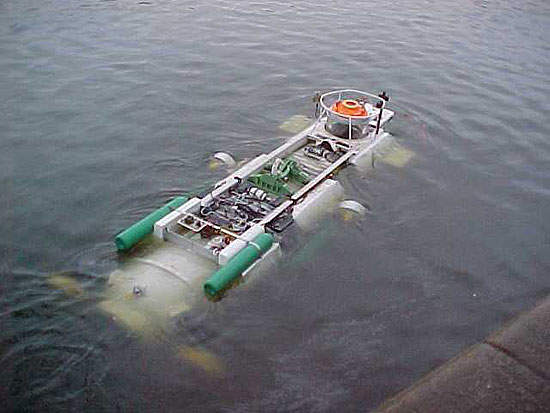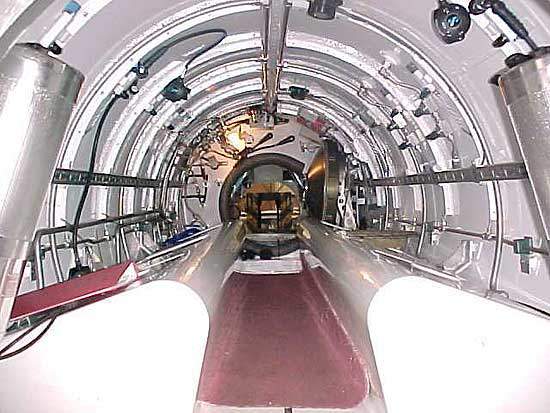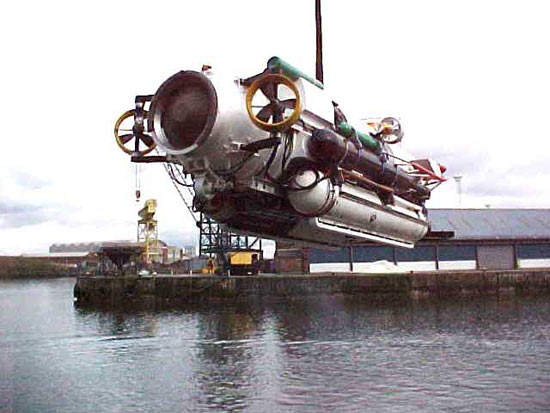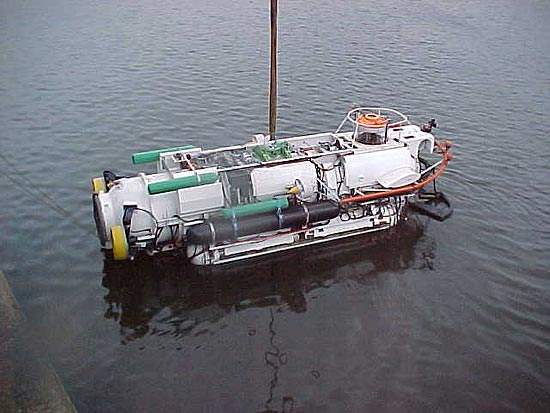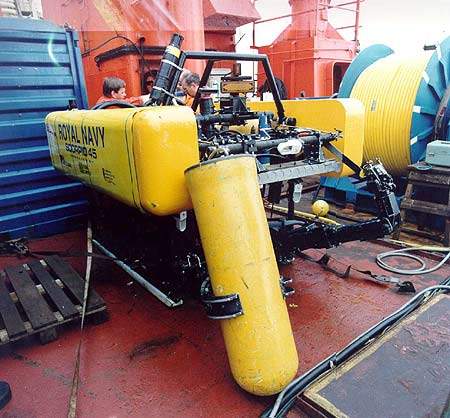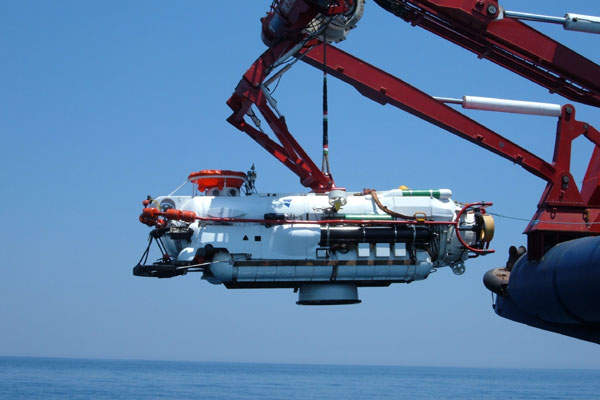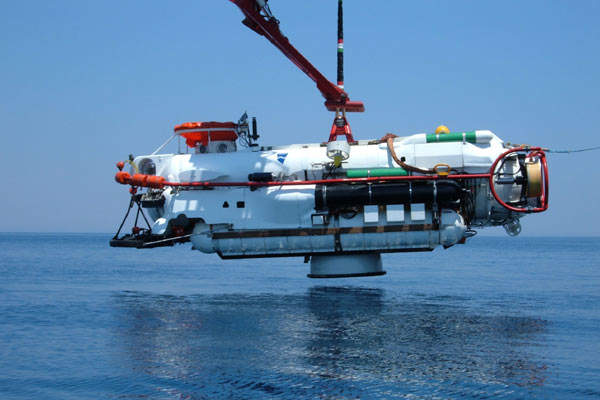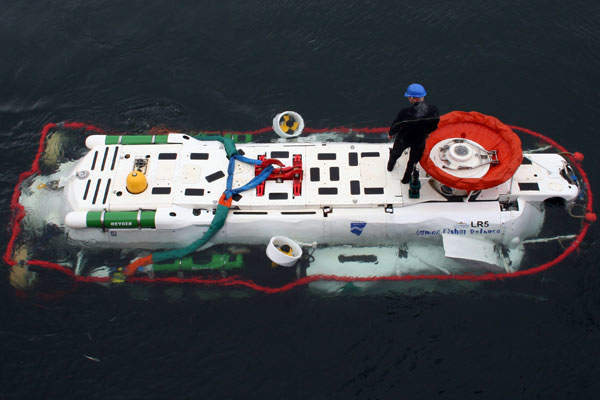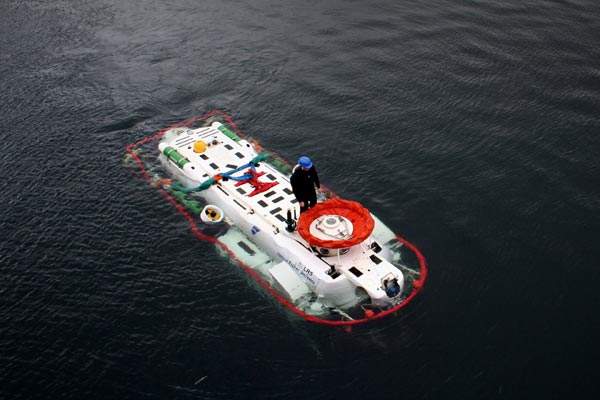The UK’s Submarine Rescue Headquarters is based at Renfrew in Glasgow, Scotland. The service is managed by the Royal Navy from the Ministry of Defence Headquarters in Bath. The operating team of pilots, engineers and technicians are employed by James Fisher Rumic Ltd to maintain and upgrade the rescue systems based at Renfrew.
The main assets of the rescue service are a remotely operated vehicle, the Scorpio 45, and the LR5 submersible vehicle to carry rescue divers down to a distressed submarine, rescue the survivors and bring them back to safety. The rescue service remains on permanent standby and is ready to mobilise to any site worldwide within 12 hours.
In August 2005, six members of the submarine rescue team used the Scorpio ROV to successfully free a trapped Priz submersible, rescuing seven Russian sailors. The Priz had become entangled in fishing nets and cables.
In June 2004, the UK, France and Norway placed a contract with Rolls-Royce for the development of a new rescue system, the Nato submarine rescue system (NSRS), which will replace the LR5.
The system will consist of a Perry Slingsby Systems Super Spartan unmanned remotely operated vehicle to locate the submarine, check for signs of life and provide emergency supplies and a three-person Perry Slingsby Systems SR1 submarine rescue vehicle which will be able to dive to depths down to 600m and rescue survivors, in groups of up to 15 at a time. Kongsberg Maritime Ltd, of Waterlooville, UK, has been contracted to provide the navigation and communication systems. NSRS will be based at the HM Naval Base Clyde. Final acceptance sea trials, which began in September 2007, were successfully concluded in March 2008 and the system is scheduled to enter service by the end of 2008.
When NSRS is fully operational, James Fisher Defence has agreed to purchase the LR5 submersible, the Scorpio ROV and other equipment to set up a commercial service for other navies. In March 2007, James Fisher Defence, along with Singapore Technologies Marine, was awarded a contract to supply submarine rescue services to the Singapore Navy from 2009. James Fisher Defence is also supplying a new rescue submersible, ROKS DSRV II, to the Republic of Korea Navy (ROKN) which will be delivered by the end of 2008.
Underwater rescue operations
Any navy will determine the position of its own distressed submarine, the condition of the survivors and the condition of the submarine. When the UK Submarine Rescue Service receives a callout, the ships in the area of the distressed submarine which are capable of hosting the rescue submersible are identified.
The service maintains a computer register of ships capable of acting as the mother ship to host the submersible rescue system. The register of ships includes large diving ships, cable ships and other ships which have sufficient deck space for the rescue system, capacity to carry the rescue team and survivors and have sufficiently high performance to operate in high sea states and speed to travel quickly to the scene of the emergency.
The host mother ship is notified and called to a port to embark the 11-strong rescue team of specialist divers and technical officers together with the rescue submersible and its associated equipment.
The submersible can be air lifted by a military or civil transporter aircraft for example by C-5 Galaxy or Antonov and then transferred to port for speedy installation on the mother ship.
For launch from the mother ship the ship’s own launch hoists can be used or alternatively an A-frame can be set up on the mother ship in under twelve hours.
Initial contact with the submarine
Rescue divers approach the distressed submarine and use the submarine’s escape hatch to transfer emergency life support stores. The divers prepare the escape hatch on the distressed submarine for the arrival of the rescue submersible.
A Scorpio remotely operated vehicle (ROV) can be used to mark the site with navigation beacons. The ROV is equipped with a sonar, a depth measuring system, tracking transponders and four video cameras. A manipulator installed on the front of the ROV can be used to clear debris from the submarine’s escape hatch. The ROV can also fit an underwater telephone and a radiation monitor, and be used to deliver life support systems to the submarine.
LR5 submersible deployment
Both the Scorpio remotely operated vehicle and the LR5 submersible are fitted with an integrated navigation and tracking outfit, developed by Kongsberg Simrad, which integrates the surface and subsea navigation data. The rescue coordinator on the mother ship uses the presentation from the navigation and tracking system and the images from the sonars and cameras to provide real-time detailed pictures of the distressed submarine and the deployed rescue systems.
The rescue submersible makes a watertight seal onto the distressed submarine’s escape hatch. The watertight seal allows transfer of personnel without submitting them to the high external sea pressure. Technicians and medical officers can be transferred to the distressed submarine if required and survivors from the submarine are transferred onto the submersible.
Up to 15 submarine survivors can be evacuated at a time to the mother ship or to a mother submarine. The LR5 could make up to eight trips to the distressed submarine (rescuing 120 survivors) before needing to recharge the battery power supply.
Portable decompression chambers installed on the mother ship are used to treat the survivors in order to avoid decompression problems. The survivors are returned to normal atmospheric pressure in controlled conditions and at a controlled rate.
LR5 submersible vehicle
The LR5 vehicle normally carries three submersible crew members, the pilot, a co-pilot and the systems operator.
The vehicle is equipped with a suite of tools including a Slingsby manipulator, an ejectable claw, secateur type rope cutters, guillotine action wire rope cutters and a 305mm disc cutter.
The communications suite on the vehicle consists of 10kHz and 27kHz underwater telephones, an acoustic pinger operating at 27.5kHz and a Model 2056 voice and pinger set, operating at 10kHz, 27kHz and 45kHz,
Operating conditions
The LR5 is capable of operating in seastate conditions generating up to 5m wave height and surface visibility of at least 1nm. The LR5 two 6kW electric motors give a maximum speed of 2.5kt, which limits the rescue operations to conditions of a maximum 1.5kt seabed current and the maximum operating depth is 500m.
Mating with the distressed submarine can be achieved in up to 1kt seabed current conditions. Where the distressed submarine is lying at an angle, a 15° skirt wedge is used to assist mating.
The LR5 has a ‘cram capacity’ of 15 at an internal pressure of five bar.

